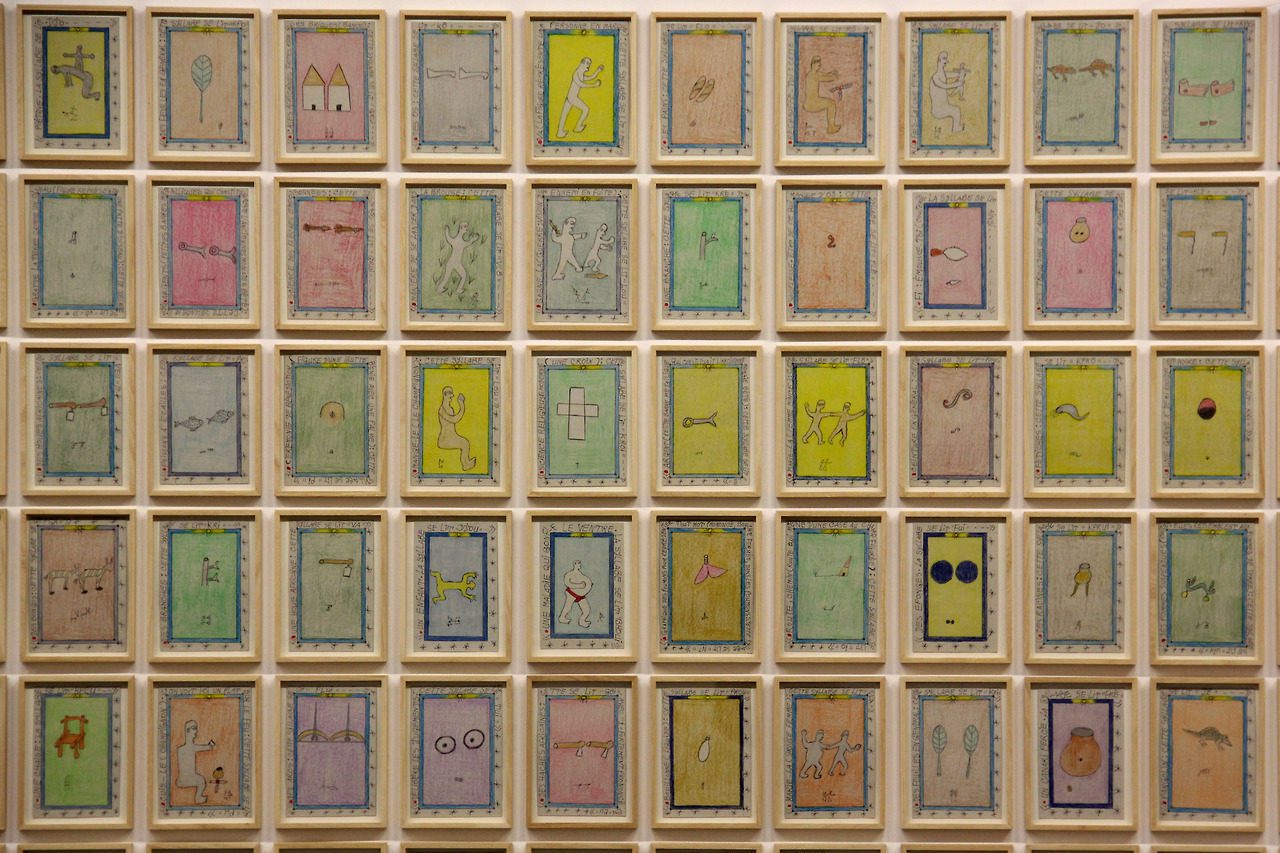Caroline Hancock pays tribute to the great visual artist and storyteller Frédéric Bruly Brouaré.

Detail from Frédéric Bruly Bouabrés series 'World Knowledge'.
The inclusion of Frédéric Bruly Bouabré’s work in major landmark international exhibitions since the late 1980s gives a significant backdrop to the late recognition of his achievements within the art world.
In his mid sixties, in 1989, he was invited to ‘Magiciens de la Terre’ presented at the Centre Pompidou in Paris. One of the adjunct curators, André Magnin, had been introduced to his work in the Ivory Coast capital, Abidjan, and he has consistently championed it since. Just to cite a few examples amongst countless biennales and major exhibitions, in 1994, Lynn Cooke created a dialogue between Bruly Bouabré and Alighiero e Boetti in ‘Worlds Envisioned’ at DIA Center for the Arts in New York; Okwui Enwezor showed work in documenta 11, Kassel, in 2002; and, last year, Massimiliano Gioni aptly included him in ‘The Encyclopedic Palace’ at the Venice Biennale.
Bruly Bouabré’s extraordinarily prolific storytelling and archiving of the world and its ways survive his recent bodily passing in Abidjan. The titles of his series of often hundreds of small drawings with texts give an idea of the scope of his pedagogical, spiritual, anthropological and artistic recording method, for instance ‘The Book of Divine Laws Revealed to the Order of The Persecuted’, ‘Knowledge of the World’, ‘Museum of African Faces’, ‘Symbols and Myths’, ‘The Universe’, ‘Stars From My Dreams’, ‘High Diplomacy’. Inspired by a well-documented solar vision in 1948 in Senegal while he was working for the Dakar to Niger railway line, he began to visualise and therefore memorialise the nearly extinct, non-written language and culture of his fellow Bété people. He famously researched and invented (or re-invented, since he is sometimes compared to Champollion who discovered the Rosetta Stone) ‘African Writing’, comprising 448 monosyllabic pictograms, and put it to use through writing and translations. Théodore Monod published the alphabet in 1958 in the bulletin of IFAN (French Institute of Black Africa), which he directed. In a 2010 documentary(1), Bruly Bouabré said about him: “I am the son of a scholar. He told me, ‘my son, in life, you have to be observant’.”
Bruly Bouabré was born around 1923 in Zéprégüé, then in the centre of French West Africa (AOF), Ivory Coast since the independence in 1960. He talks about the initial influence of patterns and forms of sacred volcanic rocks in the local forests in this region. He ceaselessly gave expression to his daily study of human customs, world affairs and ecology, as well as to chance encounters with signs found in scraps, peel, stains, cola nuts, or clouds. Abstractions and realities were ‘imaged’ for the sake of transmission, and he became known as Cheik Nadro – the revealer. He would mention his great admiration for Victor Hugo and Picasso and further remark that in fact, in his case, drawing won over literature.
His materials were simple, drawing with coloured pencils and ballpoint pen in school exercise books, on index cards or on cardboard, and sometimes on salvaged packaging. Bruly Bouabré captured life and civilisation around him in thousands of vignettes with captions attached. The narrative is told through graphic black outlines and an accompanying message in French written in capital letters in the margins, punctuated by characteristically enigmatic stars and dots. There is a constant relation between text and image in a unique blend somewhere between exquisite medieval illuminated manuscripts, tongue-in-cheek comic strips and obsessive serial global conceptualism. This naïve-looking style of drawing often led to his association with forms of outsider art or Art Brut(2). Pierre Alechinsky and the late 1940s expressionist CoBrA group might come to mind, for instance. Yet some authors compare his work to that of William Blake in the late 18th and early 19th century.
At the Palais de Tokyo in Paris until September, a flash alert commemorates the oeuvre of two senior art world figures who recently passed away – Bruly Bouabré (3) and the photographer J.D. Okhai Ojeikere.7 André Magnin has lent a series of about 150 drawings by Bruly Bouabré depicting couples from around the world getting married under a bright sun and copulating either along the Seine or the Nile rivers. As Yaya Savané(4) wrote in the catalogue of the exhibition Worlds Envisioned (1994, p. 79): “The existence of a universal kinship, the unity of the world, and the necessity of cultural crossbreeding constitute the foundation of the artistic project Frédéric Bruly Bouabré holds dear.”
Hommage à Frédéric Bruly Brouaré et Okhai Ojeikere until September 9, 2014, Palais de Tokyo, Paris.
Caroline Hancock is an independent curator, writer and editor based in Paris.
NOTES
1.
Directed by Philippe Lespinasse, Andress Alvarez, LoKomotiv Films, 2010.
2.
Sarah Lombardi, “A Self-Taught Encyclopaedist”, Raw Vision, 69, 2010.
3.
In 2012, Bruly Bouabré prepared an exhibition entitled ‘Aujourd’hui je travaille avec mon petit fils Aboudia’, introducing his grandson’s work to his home town of Abidjan in the Galerie Cécile Fakhoury.
4.
A box set containing 4 volumes dedicated to Frédéric Bruly Bouabré’s oeuvre was published in May 2013. Paris, Éditions Xavier Barral. With support from agnès b.
More Editorial